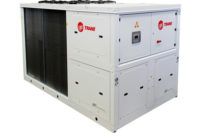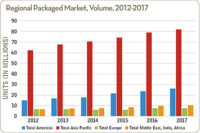Energy efficiency is becoming increasingly important due to rising energy costs, volatility in energy prices, and security of energy supply. Both the U.K. government and the European Union (EU) have challenging targets to reduce energy and greenhouse gas emissions by 80 percent compared to 1990 levels by 2050. Strategies to achieve these targets include reductions in the energy intensity of buildings, energy efficiency in industry, electrification of transport and space heating, and a shift to renewable-energy technologies for power generation.
Energy efficiency in industry and transport can be improved by improving the efficiency of individual processes and unit operations as well as energy recovery from waste streams. Energy recovered can be used in another part of the process or can be converted to “high value” electrical power. A technology that can achieve the latter is the Organic Rankine Cycle (ORC).
The Rankine Cycle is a thermodynamic cycle used to produce electricity in many steam power stations where superheated steam is generated in a boiler and then expanded in a steam turbine. The turbine drives a generator to convert the work into electricity. The steam is then condensed and recycled as feed water to the boiler. A disadvantage of using the water-steam mixture is that the steam has to be superheated to avoid two-phase flow during expansion, which can damage the turbine blades. Another disadvantage is the high temperatures required, which makes the basic cycle unsuitable for low-temperature heat recovery.
The ORC operates on the same principle, but uses an organic fluid instead of water. The major advantage of these fluids is that they can be used at lower heat-source temperatures and do not need to be superheated before expansion, resulting in higher cycle efficiencies.
A schematic diagram of a simplified ORC is shown in Figure 1 (above).
The ORC fluid enters the pump as a liquid at the condenser pressure (point 1) where it is compressed to the evaporator pressure (point 2). In the evaporator, the fluid absorbs heat from the heat source and becomes high-pressure high-temperature saturated or superheated vapor before it enters the expander (point 4). The vapor expands in the turbine, which is connected to a generator. The generator generates electrical power that can be used locally or exported to the grid. The fluid exits the expander (point 5) as a low-pressure vapor and enters the condenser (point 6), where it rejects heat and becomes liquid at (1) for the repetition of the cycle. To improve the efficiency of the cycle, a heat exchanger (recuperator) is normally installed to transfer heat from the high-pressure side to the low-pressure side of the system and reduce the temperature of the ORC fluid entering the evaporator.
The application of ORC systems has increased substantially in recent years, with applications mainly in biomass CHP plants, geothermal energy, and waste heat recovery.
Working Fluids
The choice of working fluids for ORCs depends on many factors, the most important being good thermodynamic performance. The efficiency and/or power output should be as high as possible for given heat source and sink temperatures:
• Good stability at high temperatures — high safety, low toxicity, and low flammability;
• Good environmental performance — low ozone depletion potential and low global warming potential (GWP); and
• Good availability and low cost.
Even though many working fluids have been investigated for ORC applications, the most commonly used fluids are:
• R134a — Refrigerant used in geothermal power plants or for very low-temperature waste heat recovery;
• R245fa — Low-temperature working fluid, mainly used in waste heat recovery;
• OMTS (octa-methyltrisiloxane) and n-pentane — high-temperature combined heat and power (CHP) power plants; and
• Toluene — Waste heat recovery.
Expanders
The performance of ORC systems depends to a large extent on the type of expansion machine used. Expanders can be classified into two main categories: turbomachines and positive displacement.
Most positive-displacement expanders are prototypes and are derived from compressor technology. They are piston, scroll, screw, or vane expanders and are good alternatives to turbomachines for low-output powers. They are reliable, have good isentropic efficiency and can tolerate liquid slugs during expansion.
Turbomachine-based ORCs are technically mature and are available on the market for large power outputs from around 100 kW to many megawatts. They are fully automated, have high availability, and require little maintenance.
The investment cost of ORCs is a function of the power output and can vary between £3,500 per kW for power outputs of around 100 kW to £1,000 per kW for power outputs above 3 MW. The efficiency of commercially available ORCs is in the range between 10-20 percent, depending on temperature levels of the evaporator and condenser. An increase in evaporator temperature and/or decrease in condenser temperature will lead to higher efficiencies.
Research and Development
In the last few years, there has been a substantial increase in Organic Rankine Cycle system installations for low-temperature waste heat recovery for power generation. This has been possible due to the availability of HFC 245fa, which enables the use of existing HVAC hardware, such as heat exchangers for the condenser and evaporator, pumps, and turbines, and compressors as expanders with minimal redesign. But, a potential disadvantage of HFC245fa is its relatively high GWP of 950.
Current research activity is concentrated on the investigation of new low GWP working fluids, development of new and innovative cycles, and individual component and system design optimisation and control, particularly for low power systems.
Brunel’s National Centre for Sustainable Energy Use in Food Chains (CSEF) is backed in this research by Research Councils U.K. as part of its overall funding of end use energy demand reduction, with further funding from the TSB and the Engineering and Physical Sciences Research Council (EPSRC).
The CSEF is developing test facilities in collaboration with industry, notably heat exchanger specialist GEA Searle, for investigations into subcritical cycles using low-pressure working fluids, but also transcritical cycles using CO2 as the working fluid. The facilities will be comprehensively instrumented to enable detailed component performance investigations to be carried out and the validation of mathematical models for component and system design and control.
Research courtesy of professor Savvas A. Tassou, design director for Brunel’s National Centre for Sustainable Energy Use in Food Chains (CSEF) and head of the School of Engineering at Brunel; and Dr. Yunting Ge, senior lecturer in building services engineering at Brunel. Content for the European Spotlight is provided courtesy of Refrigeration and Air Conditioning Magazine, London. For more information, visit www.racplus.com.
Publication date: 6/23/2014
Want more HVAC industry news and information? Join The NEWS on Facebook, Twitter, and LinkedIn today!






Report Abusive Comment